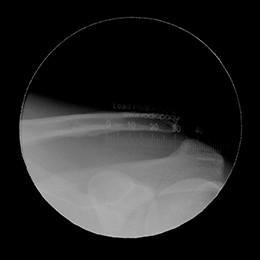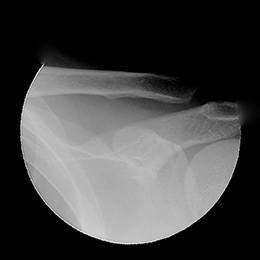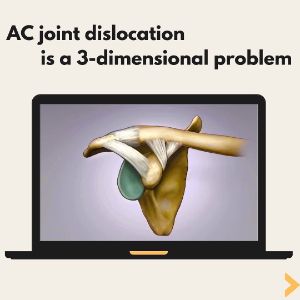Grade 3 AC Joint Separation
A grade 3 AC joint separation is a true dislocation of the AC joint. While higher grade dislocations (grade 4, grade 5, and grade 6) are more severe they only differ from a grade 3 by the severity and the direction of the displacement. Unlike more minor sprains such as a grade 1 (no displacement) or grade 2 (minor displacement), a grade 3 injury is a disruption of not only the AC joint itself but also the important supporting ligaments, the coracoclavicular ligaments. The rupture of the coracoclavicular ligaments are important, because they keep the scapula correctly positioned under the clavicle and once ruptures causes the scapula to drop relative to the clavicle. This creates an obvious cosmetic deformity (bump).
A grade 3 AC injury usually results from a fall directly onto the “corner” of the shoulder. This is common with both biking and skiing injuries. However, any direct blunt force can cause an AC joint separation if severe enough.
The initial symptoms are very severe pain, localized swelling and the notable presence of a “bump” on the shoulder. Although it appears the bump is from displacement of the end of the clavicle; its actually caused by the shoulder blade and arm drooping relative to the intact clavicle. Nevertheless it is painful and any movements of the shoulder result in significant pain.
Do I have a Grade 3 AC Joint Separation?

The initial evaluation is done in the Emergency Room or an alternative triage location such as a local clinic or doctors office. The initial x-ray will determine the AC joint as the source of injury and rule out other similar types of injuries such as clavicle fractures, shoulder joint fractures or dislocations, and other types of soft tissue injuries.
Initial treatment for AC Joint Separation?
Simple measures such as the use of ice and supportive measures such as a sling are needed to control pain for the first few days. Anti-inflammatory medications such as aspirin or Advil are helpful as well. If non-surgical treatment is selected then physical therapy can begin as soon as the pain subsides. The purpose of therapy is to reduce pain, improve motion, and build strength. Whatever deformity is present is, however, permanent.
AC Joint Separation Grading?
Definitive treatment recommendations depend on a full x-ray evaluation to determine both the severity and the direction of the displacement. This requires that x-rays be taken of both the normal and the abnormal shoulder. It is essential that the distance between the top of the coracoid bone and the underside of the clavicle be measured using digital x-ray measuring devices. This is what determines the AC joint separation grade. Unfortunately many patients are advised of their grade severity without a comprehensive evaluation and this results in many patients being told they have a grade 3 AC joint separation when in fact the injury is much worse (grade 5). A recent scientific study showed that even experienced clinicians do not accurately agree on the grade of the injury without making side-to-side digital measurements. If the distance between the two bones is at least 25% increased relative to the normal side, but less than 100% (double the distance) then the injury is considered to be a grade3 shoulder separation.
In addition more recent evidence shows that horizontal stability is important as well and cannot be evaluated with standard x-rays. Horizontal instability is an important cause of chronic pain and needs to be identified with a cross-arm x-rays looking for signs of claviuclar overlap. Note in the video below that with movement of the arm across the body that the clavicle is sliding back and forth relative to the acrmion. This causes pain!
AC Joint Surgery

The decision to have initial surgery must be individualized based on many factors such as patient age, anticipated activity level, occupation, and tolerance for chronic deformity. The latest research shows a trend towards better outcomes when the repair is done early (within the first 1-3 weeks of the injury) because the native ligaments can heal naturally as long as the joint is properly reduced and held with stable fixation. However, many patients may have excellent restoration of function without surgery so the decision must be individualized. So the question is if you have a Grade 3 AC separation should you or should you not have surgery?
Contact our practice today to schedule a consultation with Dr. Struhl.




